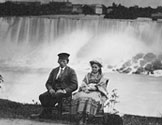

|
||||||||||||||||||||||||||||||||||||||||||
|
| ||||||||||||||||||||||||||||||||||||||||||
 |
 |
 |
 |
 Sanborn’s History Has Railroad Ties The area that today is identified as “Sanborn” was originally known as “South Pekin.” Located a mile southwest of Pekin, the village was first settled by Jarius Rose who purchased 2,000 acres of land from the Holland Land Company in 1811. He was taken prisoner during the War of 1812 by Natives friendly to the British but was later ransomed by a British officer and returned to his family who had fled to Canandaigua. He returned to Niagara County and started a two-acre apple orchard in the vicinity of what is today Niagara County Community College. He sold the infant trees for twelve each, thus establishing new orchards all over the county. Another early settler to South Pekin was Daniel Treichler, Sr. who came in 1833 and purchased land south of the village. Ironically the village was later named not in honor of Rose or Treichler but for Lee Sanborn, the son of Rev. E.C. Sanborn, a Methodist minister, who settled there in 1848. Pekin still remained the larger and busier of the two villages until the 1860s. The new Rochester, Lockport and Niagara Falls Railroad Company had bypassed Pekin in 1852 and went directly through South Pekin. A year later the RLNF Railroad was consolidated with several others to form the New York Central Railroad System. But it was a dozen years before South Pekin could boast any semblance of a village and in 1865 the railroad officially changed the name of its station there from South Pekin to Sanborn. The lots that surrounded the railroad tracks were purchased in 1864 by Lee Sanborn, Rev. Griffin Smith and his brother Ryan Smith. The Smiths used their acreage for farming but Sanborn had his land surveyed by Jesse Haines and drawn up with streets and smaller lots for homes and businesses. The railroad developed the village into a commerce center at crossroads where the towns of Lewiston, Cambria and Wheatfield meet. In the last quarter of the 19th century and well into the 20th century, the village of Sanborn continued to grow and thrive as farm produce was brought in for shipment on the railroad. Cold storage, evaporators and canning factories were built to process the produce before being shipped out. A sawmill and cheese factory were built as well as the Treichler greenhouses for growing flowers for sale in Buffalo and Rochester. Many stores and small businesses supplied the community with the necessities of life. Sanborn’s first church was actually the old wooden Methodist Church from Pekin that was moved to Sanborn in 1865. Remodeled and renamed the Sanborn Union Hall, both the Methodists and the Baptists used this facility for services until their own churches were built. In 1888 it was purchased by a Mennonite congregation for use as their church. The new First Methodist Episcopal Church was built in 1874 and the Baptists built their church in 1879. Today Sanborn is usually identified as the location of NCCC College, where Jarius Rose planted the first apple orchard in Niagara County. Douglas Farley, Director Ann Marie Linnabery Erie Canal Discover Center 24 Church St. Lockport NY 14094 716.439.0431 CanalDiscovery@aol.com www.NiagaraHistory.org |
|